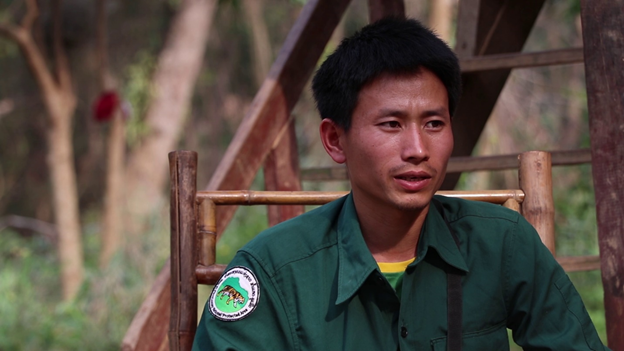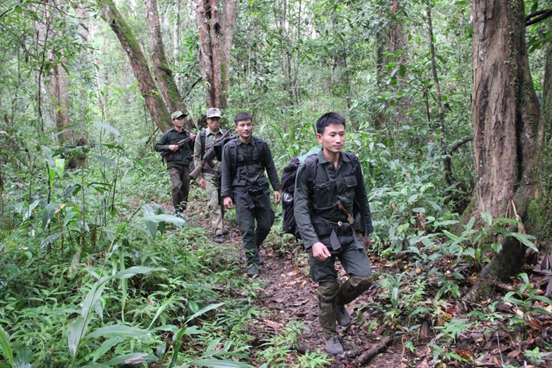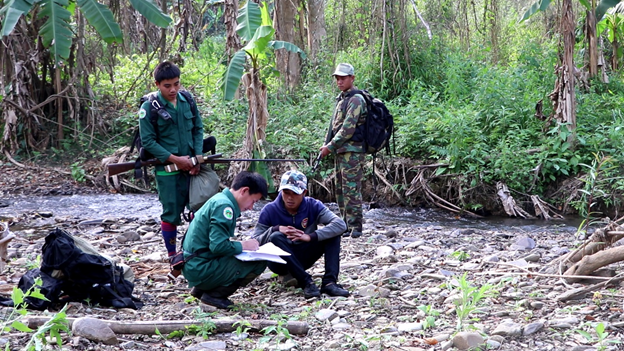
Forest Ranger, guardian of Nam Et-Phou Louey National Park Interview conducted and translated by NEPL WCS staff Mr. Jay White and Mr. Khamphui Invixay
Edited by: Manoly Sisavanh, WCS Lao PDR
Disclaimer: This project is funded by IUCN Save Our Species. The content of this article is the sole responsibility of WCS Lao PDR and do not necessary reflect the views of IUCN.
WCS Lao PDR is implementing the project titled ‘Securing Corridors to Connect Populations of Nomascus leucogenys (northern white-cheeked crested gibbons) across the Landscape of Nam Et-Phou Louey National Park (NEPL NP)’ from June 2020 to May 2022. This project aims to increase the long-term viability of populations of Nomascus leucogenys – an IUCN Critically Endangered species – in the NEPL NP in Northern Laos through increasing the protection and integrity of key habitat corridors within NEPL NP.
Today, we would like to introduce you to one of NEPL dedicated rangers, who has contributed tirelessly to the protection of Nomascus leucogenys and other fauna and flora species in NEPL NP.

Figure 1: Xionglor Suamai, Ranger of Nam Et-Phou Louey National Park
Q: Can you tell us about yourself?
A: My name is Xionglor Suamai. I’m 34 years old. I married and have three kids: two boys and one girl. I was born in Ban Pha Daeng Village in Viengkham District of Luang Prabang Province, on the western border of Nam Et-Phou Louey National Park.
Q: How long have you been a ranger for Nam Et-Phou Louey National Park?
A: 5 years
Q: Explain what a patrol of Nam Et-Phou Louey National Park is like. Where do you patrol? What is your goal and what are your objectives? Who do you patrol with? How do you travel? How long do your patrols go for?
A: I typically patrol the forests inside the Totally Protected Zone of Nam Et-Phou Louey National Park. Our goal is to protect the forests and wildlife of the park from threats, so our objectives are preventing illegal poaching and forest destruction or disturbance inside the Totally Protected Zone by confronting the persons responsible. I usually patrol with one other NEPL ranger and two soldiers from the provincial military who accompany us for safety and legal authority. We normally spend 7 days and six nights at a time on patrol in the forest and are delivered to and picked up from our patrols by a car from the park office. Because the forest is so thick and the topography is so steep, we do most travel by following streams and ridgelines; sleeping at streams where we can get clean water for cooking, drinking, and washing, except in the rainy season when the streams can be very dangerous and we sleep higher up the hills or on the ridge tops. Travel can be very slow and difficult when the forest is thick with bamboo or vines, or when traveling through disturbed forest or grasslands where the vegetation is very thick; it is much easier to travel through mature forest with large trees where the low vegetation is not as thick.
Q: When you are on patrol in the forest, explain in general, a typical day from start to finish.
A: The team typically wakes up between 4 and 6 AM, depending on the requirements for the following day. The first thing we do is prepare food for the rest of the day. We avoid making fires when not necessary so as to not notify poachers in the area of our presence through smoke from our cooking fires, so we prepare lunch and sometimes dinner early in the morning in advance. Normally, the food which we carry to eat includes: sticky rice (soaked overnight and steamed first thing in the morning), grilled meat (usually pork and sometimes beef), instant noodles, instant coffee, salted fish, and eggs; we also carry dried chilies, salt, MSG, garlic, and shallots for flavor. Over the first couple days we may eat vegetables from the market as well such as eggplant or pak choy kale but these go bad very fast. While cooking, the team members pack up their belongings and clean camp. We normally eat breakfast just before we start walking to continue our patrol plan; between 6 and 7 AM.
We usually look for a place to camp by 4 or 5 PM but sometimes do not get the opportunity to set up a new camp till as late as 9 PM. Good camp spots will be along streams with clean water where we can wash and cook with ease. Many streams are in very deep and narrow gullies and setting up camp can be difficult; ideal camps are in wider valleys with some flat land near the stream and large mature trees. The exception is in the rainy season when these streams have the danger of flooding and we must camp higher up the hill. On arriving at camp, the first thing we do is to soak a new batch of sticky rice and gather firewood. We then re-steam our leftover rice and cook dinner while taking turns to wash in the stream. After eating, I (the team leader) or the deputy ranger compiles the SMART data and GPS waypoints from the day, filling in the details in the SMART data collection forms. We then sleep for the night. Usually we sleep in hammocks with mosquito nets and rain sheets but may sleep on the ground on very cold nights in January or February or when we are not among large enough trees.

Figure 2: Mr Xionglor Suamai patrolling with team on an Eco-tourism trail in Nam Et-Phou Louey National Park
Q: How do you sleep while on patrol? Do you fall asleep easily and sleep till the morning or do you toss and turn a lot?
A: Usually most rangers sleep well in their hammocks but often we cannot sleep if we are missing our families or maybe thinking about difficulties in work or the things we need to take care of at home.
Q: What kind of animals do you see while on patrol?
A: We often see sambars, serows, and muntjacs and frequently see civets, monitor lizards, and macaque monkeys.
Q: Do you ever see bears or other large carnivores?
A: Very rarely, we usually only see their tracks or scat or claw marks on the trees.
Q: Do you ever see gibbons?
A: Very rarely. I have seen gibbons directly only two or three times in five years of patrolling.
Q: Do you often hear gibbon songs?
A: In some areas we hear their songs every time we go. In other areas we never hear them at all. It also depends on the weather and where we sleep or are walking in the early morning.
Q: What is your favorite animal to see in the forest?
A: sambar
Q: Not serow?
A: I see serow all the time, sambar are more exciting.
Q: What is the most difficult part of being a ranger?
A: Carrying the heavy packs and crawling with heavy packs through thick vegetation. Also, crossing deep gullies where you spend half the day climbing down into the gully and the rest of the day climbing back out, spending all day to only move a couple kilometers.
Q: What do you do when you encounter someone doing something illegal in the forest?
A: We will try to apprehend anyone we see doing illegal activities in the forest such as hunting with firearms or other illegal gears.

Figure 3: Staged reenactment of Mr Xionglor Suamai and team drafting litigation for an apprehended poacher in Nam Et-Phou Louey National Park
Q: What is the process when an offender is apprehended?
A: We first confiscate all their gear, most importantly any knives or other potential weapons. Then we discuss with them the offense they are being charged with. We take clear photos of the offenders, the team, and all the gear and other materials on the offender’s person. We then draft an agreement with the offenders, detailing personal information and specifics about the offense and have them acknowledge the litigation with a thumb stamp. Then we will accompany the offenders out of the Totally Protected Zone if this is where they were caught.
Q: What is your favorite thing about being a NEPL ranger?
A: I like helping the environment and the forests and wildlife. Good healthy forests provide us with food and clean air and water and improve the quality of our lives, I like being part of promoting these things.
Q: What do you think the most important qualities are for being a ranger?
A: Most important thing is that you are honest and opposed to corruption and that you follow the rules of the job and the rule of law. Second is that you have good endurance, both mental and physical. Third most important quality is that you cooperate well with others and can work as a team member. After these, it is also good to have knowledge of the forest and wildlife, to have basic literacy, and to have the ability to learn to use new technologies and techniques like using a GPS and compass, reading maps, and the details of Lao law.
Q: Who would you recommend this job for? Are farmers or persons from private or government offices better? How about younger or older persons? Married or single?
A: Either farmers or office workers can be suitable for the job if they have the qualities I mentioned. However, farmers tend to have more endurance and more forest skills than those who have been working in the office. Younger or older persons can do it, depending on individual strength and endurance; same with married versus single persons.
Q: Does Nam Et-Phou Louey employ any women rangers?
A: No, none.
Q: Why? Do you think Lao women could do the job?
A: I think they could. I don’t know why we don’t have any women rangers.
Fast fact: NEPL NP is renowned for its rich wildlife biodiversity with a wide range of species, many endangered, including clouded leopards, dholes, northern white-cheeked gibbons, Phayres langur, sun bears, Asiatic black bears, three species of otter, five species of hornbill, two species of pangolin, and numerous species of civets. Altogether there are more than 20 carnivore species including six species of wild cats, more than fifty species of mammals and 299 species of birds.
We thank Xionglor Suamai for his tireless efforts in protecting the large area of NEPL NP, home to the Critically Endangered Nomascus leucogenys protected under the IUCN Save Our Species project.